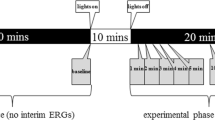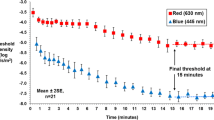Abstract
To assess the inter-session repeatability of the Goldmann-Weekers adaptometer for the measurement of cone dark adaptation in a population of healthy subjects. Data were obtained from 31 healthy adults (mean age 21.5 ± 2.5) on 2 days. At each visit, pupils were dilated and a 96% bleach of cone photopigment was administered to the test eye before threshold was monitored continuously for 5 min in the dark using the Goldmann-Weekers adaptometer. A single exponential function was fitted to the threshold recovery data on a least squares basis. The coefficient of repeatability (CoR) was calculated to assess the repeatability of the time constant of recovery (τ), initial threshold and final threshold. Cone dark adaptation functions were successfully recorded from all subjects on both visits. The CoR was 79.48 s for τ, 0.71 log cdm−2 for the initial threshold, and 0.58 log cdm−2 for the final threshold. Paired samples t-tests showed that there were no significant differences between visits for any of the parameters assesed. Although the Goldmann-Weekers adaptometer was capable of monitoring the rapid changes in threshold that occur during cone dark adaptation, the CoR for τ was relatively large compared to the mean recovery time constants (126.48 ± 40.33 and 119.94 ± 33.25 s at the first and second visits, respectively). This indicates that the Goldmann-Weekers adaptometer is unlikely to be a useful instrument to chart changes in an individual’s vision over time.


Similar content being viewed by others
References
Moore AT, Fitzke FW, Kemp CM, Arden GB, Keen TJ, Inglehearn CF, Bhattacharya SS et al (1992) Abnormal dark adaptation kinetics in autosomal dominant sector retinitis pigmentosa due to rod opsin mutation. Br J Ophthalmol 76:465–469
Sandberg MA, Pawlyk BS, Berson EL (1999) Acuity recovery and cone pigment regeneration after a bleach in patients with retinitis pigmentosa and rhodopsin mutations. Invest Ophthalmol Vis Sci 40:2457–2461
Phipps JA, Guymer RH, Vingrys AJ (2003) Loss of cone function in age-related maculopathy. Invest Ophthalmol Vis Sci 44:2277–2283
Binns AM, Margrain TH (2007) Evaluating retinal function in age-related maculopathy with the ERG photostress test. Invest Ophthalmol Vis Sci 48:2806–2813
Owsley C, McGwin G Jr, Jackson GR, Kallies K, Clark M (2007) Cone- and rod-mediated dark adaptation impairment in age-related maculopathy. Ophthalmol 114:1728–1735
Dimitrov PN, Guymer RH, Zele AJ, Anderson AJ, Vingrys AJ (2008) Measuring rod and cone dynamics in age-related maculopathy. Invest Ophthalmol Vis Sci 49:55–65
Phipps JA, Yee P, Fletcher EL, Vingrys AJ (2006) Rod photoreceptor dysfunction in diabetes: Activation, deactivation, and dark adaptation. Invest Ophthalmol Vis Sci 47:3187–3194
Newsome DA, Negreiro M (2009) Reproducible measurement of macular light flash recovery time using a novel device can indicate the presence and worsening of macular diseases. Curr Eye Res 34:162–170
Kemp CM, Jacobson SG, Faulkner DJ, Walt RW (1988) Visual function and rhodopsin levels in humans with vitamin A deficiency. Exp Eye Res 46:185–197
Cideciyan AV, Pugh EN, Lamb TD, Huang YJ, Jacobson SG (1997) Plateaux during dark adaptation in Sorsby’s fundus dystrophy and vitamin A deficiency. Invest Ophthalmol Vis Sci 38:1786–1794
Hecht S, Shlaer S (1938) An adaptometer for measuring human dark adaptation. J Opt Soc Am 28:269–275
Goldstein EB (1975) Design for a dark adaptometer. Behav Res Methods Instrum 7:277–280
Henson DB, Allen MJ (1977) A new dark adaptometer. Am J Opt Physiol Opt 54:641–644
Friedburg C, Sharpe LT, Beuel S, Zrenner E (1998) A computer-controlled system for measuring dark adaptation and other psychophysical functions. Graefes Arch Clin Exp Ophthalmol 236:31–40
Jackson GR, Owsley C, McGwin G (1999) Aging and dark adaptation. Vis Res 39:3975–3982
Peters AY, Locke KG, Birch DG (2000) Comparison of the Goldmann-Weekers (TM) dark adaptometer and Scotopic Sensitivity Tester-1 (TM). Invest Ophthalmol Vis Sci 40: 3763B3621
Jackson GR, Felix T, Owsley C (2006) The Scotopic Sensitivity Tester-1 and the detection of early age-related macular degeneration. Ophthalmic Physiol Opt 26:431–437
Resnikoff S, Pascolini D, Etya’ale D, Kocur I, Pararajasegaram R, Pokharel GP, Mariotti SP (2004) Global data on visual impairment in the year 2002. Bull WHO 82:844–851
Dieterle P, Gordon E (1956) Standard curve and physiological limits of dark adaptation by means of the Goldmann-Weekers adaptometer. Br J Ophthalmol 40:652–655
Hollins M, Alpern M (1973) Dark adaptation and visual pigment regeneration in human cones. J Gen Physiol 62:430–447
Bland JM, Altman DG (1986) Statistical methods for assessing agreement between two methods of clinical measurement. Lancet 1:307–310
Acknowledgments
This study was funded by a research grant from The College of Optometrists, UK. We would like to thank Katie Kenny for her help with data collection.
Author information
Authors and Affiliations
Corresponding author
Rights and permissions
About this article
Cite this article
Gaffney, A.J., Binns, A.M. & Margrain, T.H. The repeatability of the Goldmann-Weekers adaptometer for measuring cone adaptation. Doc Ophthalmol 122, 71–75 (2011). https://doi.org/10.1007/s10633-011-9261-6
Received:
Accepted:
Published:
Issue Date:
DOI: https://doi.org/10.1007/s10633-011-9261-6




